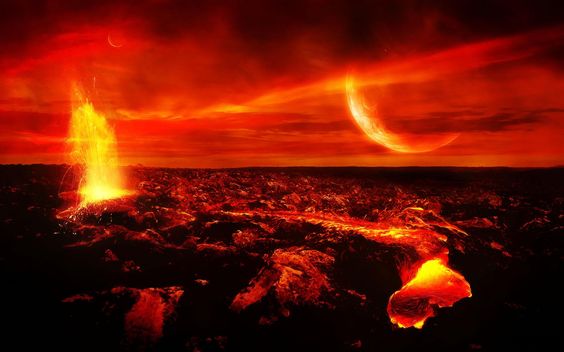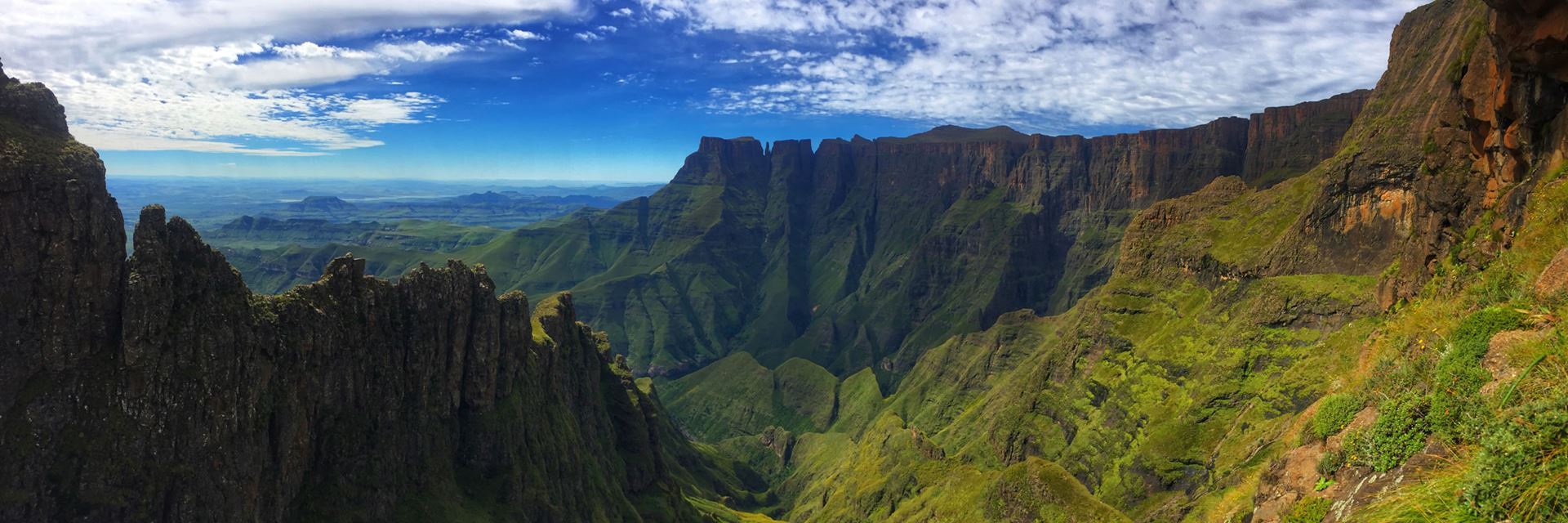A Fiery Embrace
It was a 160 million old Dante's Inferno visited upon the Earth. Lava and ash spewed across thousands of kilometres of Gondwana landscapes, incinerating everything in their path. Nothing escaped. It was the cataclysmic event that took place as Gondwana began to be torn asunder. The world was never the same thereafter. Read on to find out more.

Flood Basalts - An artist's impression. Image from wallpaperstock.net
Incandescent, red hot lavas pour out from a myriad of fissures in the Earth's crust. The flowing, rumbling mass spreads over the landscape, consuming all in its path. Scattered trees form paltry obstacles to the inexorable advance of the lava front, bursting suddenly into flame to add to the mind-blowing display of fireworks. Ponded water in the desert depressions is vaporised in hissing clouds. Dinosaurs dart hither and thither, but always away from the lava front, but their efforts to escape are ultimately in vain. Ejecta spew skywards from the fissures, filling the air with molten bombs. Ignimbrites – hot ash clouds which vent from some of the fissures - fill the air, and the ash falls back to Earth, accumulating in layers which are then buried by subsequent lava flows. It is a 160 million old Dante's Inferno visited upon the Earth.
Out of fissures poured millions upon millions of cubic metres of molten, incandescent lava.
Gondwana is under stress due to increased mantle activity beneath the continent, leading to uplift and rifting. Tensional stresses cause the crust to pull apart and out of these fissures pour millions upon millions of cubic metres of molten, incandescent lava. At the end of this volcanic event a thickness in excess of 2000 m of material will have flowed out across the Gondwana landscape, burning and burying everything before it in a fiery embrace. These kinds of outpourings are aptly known as flood basalts, and have occurred in a few localities around the world. A walk up Sani Pass will reveal the evidence of this cataclysmic event. The lava flows are quite easy to make out, as their bases are marked by pipe amygdales. We are all familiar with the shaken can of cola – once the can is opened the cola comes pouring out with its attendant mess.

Flood Basalts of the Drakensberg - www.audleytravel.com
Lavas behave similarly – their origins are the deep bowels of the Earth and, on reaching the surface where temperatures and pressures are low, the dissolved gas and fluids are free to expand and escape from the molten rock. Close examination of many of the Drakensberg Basalts will reveal round, white nodules within the greater grey groundmass. These are amygdales. At the bottom of the flows, most probably due to the chilling effect of the cooler material below, long pipe amygdales formed which rose up through the molten material, before being eventually frozen into the surrounding rock once temperatures had fallen.
Which was once red-hot volcanic ash which fell to Earth
In places it is possible to work out the direction of flow of the lava, as the pipe amygdales are dragged in the direction of flow. Pahoehoe (pronounced pa-ho-ee ho-ee) lavas also occur. A Polynesian word used to describe the ropy, crumpled texture of fresh lavas, particularly well-known from the Hawaiian Islands; these same textures are also preserved in the 160-million-year-old lavas of the Drakensberg. If you are observant, and possibly know what you are looking for, there is a horizon of welded tuff about half way up the pass on the left-hand side. This once was red-hot volcanic ash which fell to Earth and became welded together to form the ash horizon.
Feeder pipes which carried the molten lavas upwards
The next big question of course is how all this lava got to the surface through all the underlying rock. Well, scattered throughout KwaZulu-Natal and much of the Karoo for that matter are thousands of dolerite dykes, which were the feeder pipes which carried the molten lavas upwards to be extruded on the surface. These dykes now form areas of elevated relief throughout much of the country. Some of these dykes also cross cut the Drakensberg basalts themselves – carrying lava ever higher in the volcanic pile.
Dolerite bodies the size of small towns
In addition to the vertical dykes are horizontal sills, which intruded along the sedimentary bedding planes before solidifying. Many of the koppies and hills are now capped by dolerites which form a hard, erosion resistant layer which protects the underlying softer sediments from erosion. Some of these dolerite bodies are of significant size - the size of small towns in places. Some have significant commercial value, making a fine aggregate for both concrete and road building.
Two thousand metres of lava were poured out onto the planet's face
The Drakensberg owes its existence to tensional forces in the Earth's crust which rang the death knell of the supercontinent Gondwana. Over two thousand metres of lava were poured out onto the planet's face, destroying everything in its path, and covering much of Southern Africa. The Drakensberg and the Lesotho Highlands are nothing but a remnant of a far larger accumulation of basalt that flooded across several of the Gondwana continents.
Plate tectonics is the driving force that makes the rock cycle turn. The rocks that are formed are fascinating in their mineralogy and chemistry. The weathering products find themselves deposited in sedimentary wedges on the continental shelves. Some of these may find their way to the deep ocean floor as turbidites. Creatures crawl in this abyssal ooze. It is an amazing story, so if you are interested in finding out more, sign up to stay informed on our courses and new blog posts.
A promise. We will not share your details with 3rd parties, spam you or send you dodgy stuff. However we may send you promotional material pertaining to our new courses and field trips.
If this resonates with you and you think it may be valuable to others, please share, and leave your comments in the box below.
So looking forward to adventuring with you

